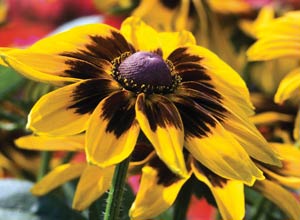7/15/2009
A Rocky Mountain Rudbeckia
Jessica DeGraaf

In the past few years, the genus rudbeckia has experienced a resurgence of sorts among gardeners. New breeding work now offers gardeners many options with respect to height, flower sizes, form and color. The versatility, long blooming season and superior heat tolerance that endeared this variety to gardeners for years is now infused with exciting new forms and colors.
The new Denver Daisy from Benary has set itself apart from other rudbeckias due primarily to its interesting story and unique appearance. Chosen by the City of Denver to be used as part of a citywide beautification project for the 150th anniversary of the city, Denver Daisy gained wide acclaim for its excellent garden performance and heat tolerance in a variety of settings. More than three million seeds were sown and planted throughout the metropolitan Denver area, creating a large amount of interest in this product.
Rudbeckia hirta culture is well- known among growers, but there are often questions related to flower initiation, plant growth regulators, summer production and so on. At right are a few production tips to help you produce a premium rudbeckia crop.
Plug production
The best thing you can do on a practical scale is to keep plug trays under short days (SD) until all plants to be transplanted have at least seven true leaves. Even 11 hours of light is sufficient to provide SD conditions under which to build the rosette. Research has shown that seven true leaves is the critical point in which the plant has achieved enough maturity to initiate flowers. Once you’ve achieved seven true leaves, the plant is sufficiently mature and will initiate flowers naturally under long day (LD) conditions. The larger the rosette, the more true leaves and the more flowers. Conversely, if the plant doesn’t have seven true leaves, flower initiation won’t occur.
Flower initiation
Rudbeckia hirta is an obligate LD plant that requires at least 12 hours of light for flower bud initiation. Daylength requirements vary between varieties; however, Denver Daisy is less daylength responsive than any of the other rudbeckias in its height class. Flowers can be initiated with 12 to 12.5 hours of light. Because it’s less daylength responsive, Denver Daisy will flower up to two weeks sooner than other tall rudbeckias on the market.
Summer production
Production of rudbeckia in the summer months can be challenging. Temperatures, especially night temperatures and longer daylengths (greater than 15 hours) cause stem elongation and make it difficult to control height. To combat this, two different regimes can be used:
Plant growth regulators
Denver Daisy is a vigorous grower that benefits from PGRs applied one to two weeks after transplant. The following are suggested concentrations that we’ve found to be effective:
• 3,750 ppm B-Nine
• 2,000 ppm B-Nine/5 ppm Sumagic tank mix
Application rates will vary based on geographical location and time of year. As always, follow the guidelines on the label.
Light manipulation
Once flower buds have been initiated, place plants under SD. This will improve overall plant quality and habit. Even two weeks of SD following flower initiation will decrease stem elongation significantly. Cooler temperatures also improve plant quality.
Fertilization
- Feed weekly at 150 ppm nitrogen using a well-balanced fertilizer mix.
- Final garden height
- Denver Daisy reaches heights of 18 to 20 inches in the garden.
- Containers
- Grow in a 1-gal. pot with one plug per pot.
- Crop times
- Plugs (128-plug tray): Five to six weeks.
- Transplant to flower (1-gal.): 10 weeks.
Jessica DeGraaf is product support specialist for Ernst Benary of America, Inc.